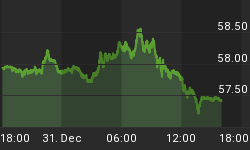Since the advent of the credit crisis, stock markets, real estate and the US dollar have been the subject of investors' angst. However, two markets - commodities and long bonds - have remained in bullish trends. That, at least, is the way it looked until recently.
The Reuters/Jeffries CRB Index hit a peak on March 13, and I argued in a subsequent post that although a correction was overdue, the long-term trend was still upwards.
But what about the outlook for US bonds, especially as yields have edged up since the recent lows of 3.314% (March 17) and 4.165% (March 20) for the 10-year and 30-year Treasury Note respectively?
The graph below shows the long-term movement of the yield on the US 10-year Treasury Note, indicating that long-dated US bonds have experienced a multi-year bull market and are trading at levels last seen more than 40 years ago as far as nominal yields are concerned and 28 years ago in real terms. Thinking of which, the only investors who first-hand experienced the last major bear market in bonds (from 1971 to 1980) are now all on the wrong side of 50!

Source: I-Net Bridge
Let's now turn to a shorter-term graph of the 10-year Treasury Note yield in order to see the recent action.

Source: StockCharts.com
The chart illustrates the sharp fall in the yield over the past few months as investors scrambled for safe-haven investments as the subprime fallout intensified. Although the yield has bounced off the bottom Bollinger Band (bottom green line), no sell signal as such has been given. However, the positive divergence of the Stochastic Oscillator is of some significance as it often acts as leading indicator of the yield graph. Although the 50-day moving average (off-blue line) could provide a short-term barrier, the real test will be the February high of 3.917%, which also coincides with the top Bollinger Band (top green line).
It would be remiss not to also show the weekly chart of the 30-year Treasury Note yield, and specifically to point out the triple bottom that has formed over the past five years, providing particularly strong support in the 4.15% to 4.20% area.

Source: StockCharts.com
Why would long bond yields be breaking upwards (i.e. why would long bond prices be topping out) from a fundamental perspective? Bonds could be discounting better business prospects a few quarters down the line, or they could be discounting rising inflation ahead, or perhaps both. Quite a likely scenario is that we could see a continued base formation for a while longer as the forces of inflation versus deteriorating/improving economic prospects play themselves out.
Time will tell when bond yields will hit a secular low, but in the meantime one should be cognizant of the fact that an investment in a 10-Year Treasury Note will by definition lock in a total return of 3.5% over the next 10 years. This sounds unsustainable and I find it difficult to see the long-term investment merit of such an investment. Long-dated bond prices could be hit hard once yields adjust to more realistic levels.
Be careful - we're in injury time.
PS: South Korea pension fund shuns US debt
I have just been alerted to a very topical article that recently appeared in the Financial Times. The relevant paragraphs are republished below:
"The world's fifth-largest pension fund will no longer buy US Treasuries because yields are too low. The move signals what could be a big shift by financial institutions away from US government debt into higher-yielding assets.
"South Korea's National Pension Service, which has $220 billion in assets, said on Wednesday it wanted to broaden its range of overseas investments.
"'It is difficult to buy more US Treasuries because the portion of our Treasury investment is already too big and Treasury yields have fallen a lot,' said Kwag Dae-hwan, head of global investments at the NPS. 'We need to diversify our portfolio away from US Treasuries and we find asset-backed securities and corporate debt more attractive because of wider credit spreads.'
"A manager at the NPS's overseas investment team said: 'The Fed continues to cut interest rates. We are still making profits from the Treasuries that we bought in the past but we think we'd better dispose of them and had better buy higher-yielding European-government debt.'
"Central banks from 16 Asian countries said last weekend at a meeting in Jakarta that they might invest more of their $1,000 billion of official reserves in one another's sovereign bonds instead of US Treasuries, given the dollar's volatility."
Source: Financial Times, March 26, 2008.
















